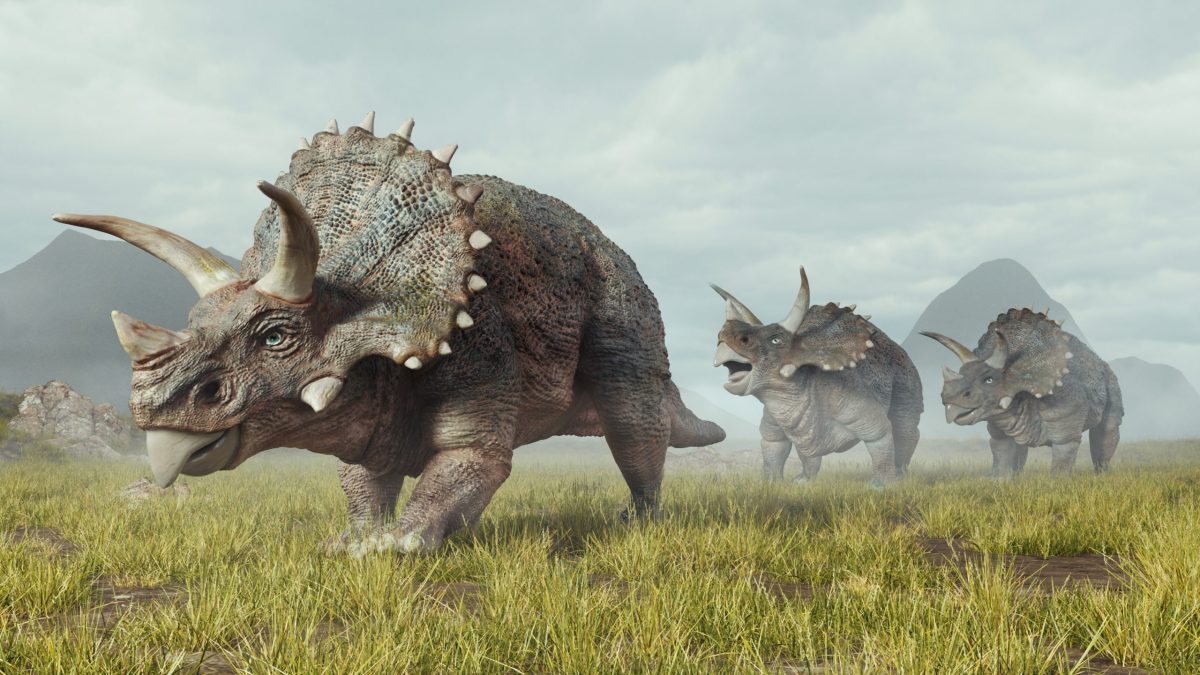5 Facts About Triceratops Horridus
Posted on Categories Discover Magazine

Imagine living in a world with a bus-sized “three-horned face” dinosaur that has epic battles with an intimidating carnivore like the Tyrannosaurus rex (or so the legend says). From all we’ve gathered so far, it is not hard to see that Triceratops horridus, also known as Triceratops (genus), is a distinct beast.
Triceratops is a quadrupedal dinosaur of the ceratopsian family – herbivores from the Cretaceous period with a bony frill and distinct beaklike bone. They used to live in western North America, in an area now composed of arid prairie and badlands. At least, this is where triceratops fossils have been extensively found.
Paleontologist O.C. Marsh officially classified it in 1889. But only after other scientists mistook it for a bison, given its size and anatomic similarities. Scientists believe the Triceratops measured approximately 30 feet long, weighing about 12,000 to 16,000 pounds.
Interesting Facts About Triceratops
Whether you are a dinosaur enthusiast or not, let’s face it, we are still uncovering a lot of mysterious aspects about these fascinating creatures! Here are five intriguing facts about T. horridus you should know.
1. The Last Non-Avian Dinosaur to Inhabit the Earth
If the picture of the T. horridus clashing with the T. rex excites you, now envision the last battle of its life, 66 million years ago. A 7.5-mile-wide asteroid crushed the Earth (in the area of Mexico’s Yucatán Peninsula), decimating 75 percent of life, including that of this recognizable species.
After three million years of roaming this planet and evolving, once the cataclysmic event occurred, Triceratops became one of the last non-avian dinosaurs to inhabit the Earth – a distinction left for a few.
Read More: Did Humans and Dinosaurs Ever Live Together?
2. There Are Only Two Types of Triceratops: Horridus or Prorsus
Based on differences in cranial anatomy, paleontologists had initially believed there to be 16 types of Triceratops. Currently, they only acknowledge two species: T. horridus and Triceratops prorsus.
Though there are similarities between the two species – both massive and bulkier than an elephant – you can also spot slight differences. For example, T. horridus had a shorter nasal horn, an elongated snout, and forward-faced top horns. On the other hand, T. prorsus held up a shorter snout, longer nasal horn, and more vertical top horns.
Studies on the evolution of the two species have led some paleontologists to speculate that they came from an earlier lineage of dinosaurs. Yet, they also suggested that both lived on Earth during the same period.
However, a 2014 study on evolutionary trends in dinosaurs contradicted this hypothesis. Analysis of over 50 skulls from the Hell Creek Formation discovered that skulls of T. horridus and T. prorsus occurred on different rock surfaces: horridus in the lower layers, prorsus in the top layers. Interestingly, skulls of both species appeared in the middle layers.
These findings led scientists to suspect that T. horridus adapted to the other breed (T. prorsus) within the span of one or two million years.
3. Triceratops Frills Might Be Used for Mating
For centuries, scientists have studied Triceratops fossils to understand their behavior. And the frills are of much interest overall – not to say a bit of controversy.
Earlier findings suggested that the bony frills could have been used as a shield against predators. Evidence has shown some diseases or wounds on fossils, in the areas of the frills and horns, consistent with bite marks of Tyrannosaurus. Also, these giant beasts may have fought against themselves.
Other initial hypotheses about the frills proposed that Triceratops used them as temperature-controlled radiators. Some even theorized that the frills might be means of identification between distinct ceratopsian species.
However, recent theories debunked these claims. It is suggested that the frills played a role in the socio-sexual selection process by helping the species subdue their foes and choose their mates.
Read More: How Did Dinosaurs Have Sex, Anyway?
4. Triceratops Fossils Are Among the Most Excavated
The Hell Creek Formation in Montana is a region particularly rich in Triceratops fossils. Through the years, paleontologists have had their hands full excavating these fossils – as Triceratops skeletons are the most popular fossils they find.
What’s more? They could identify consistent behavior patterns within this group of dinosaurs. Paleontologists hardly ever discovered their fossils in groups of three or more, leading scientists to believe that far from their ceratopsian counterparts, Triceratops tended to live alone.
5. If the Triceratops Skeleton Is Complex, the Teeth Are One-of-a-Kind
The T. horridus also had a colossal skull of approximately 3 feet. In fact, it was so big that it was among the largest of the earthly creatures.
Besides the prominent horns above its eyes and snout, T. horridus possessed around 19 to 26 small spikes, called epoccipitals, on the frills. The bony frills sat at the back of the skull.
The triceratops teeth also played a pivotal role in their diet. Despite being plant-eating dinosaurs, T. horridus had strong upper and lower jaws, forming covered rows of serrated teeth. With parrot-like beaks (named rostral), their teeth were vital for reaching and tearing plants lying near the ground. To this point, scientists suggest that the beak-like mouth helped the dinosaur eat hard-to-reach, dense vegetation.
Read More: What We Know About the Hard-Headed Pachycephalosaurus